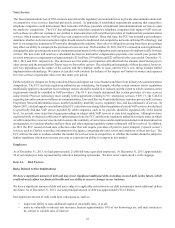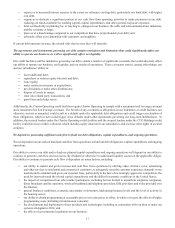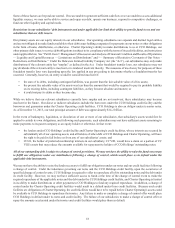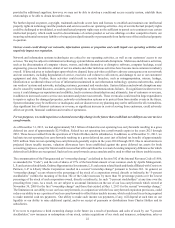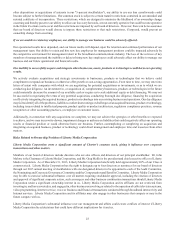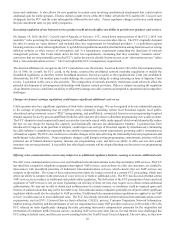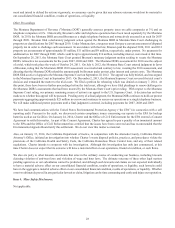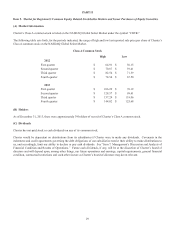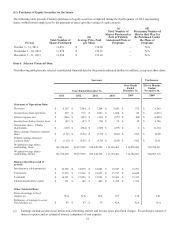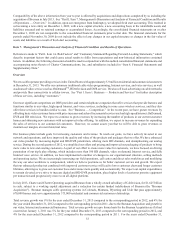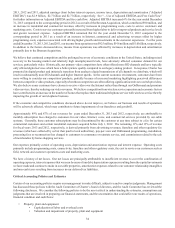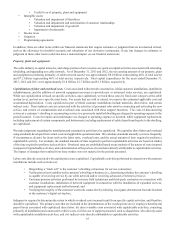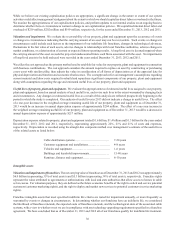Charter 2013 Annual Report Download - page 40
Download and view the complete annual report
Please find page 40 of the 2013 Charter annual report below. You can navigate through the pages in the report by either clicking on the pages listed below, or by using the keyword search tool below to find specific information within the annual report.26
terms and conditions It also allows for new penalties in certain cases involving unauthorized attachments that could result in
additional costs for cable operators. Electric utilities sought review of the 2011 Order at both the FCC and the D.C. Circuit Court
of Appeals, but the FCC and the court subsequently affirmed the new rules. Future regulatory changes in this area could impact
the pole attachment rates we pay utility companies.
Increasing regulation of our Internet service product could adversely affect our ability to provide new products and services.
On January 14, 2014, the D.C. Circuit Court of Appeals, in Verizon v. FCC, struck down major portions of the FCC’s 2010 “net
neutrality” rules governing the operating practices of broadband Internet access providers like us. The FCC originally designed
the rules to ensure an “open Internet” and included three key requirements for broadband providers: 1) a prohibition against
blocking websites or other online applications; 2) a prohibition against unreasonable discrimination among Internet users or among
different websites or other sources of information; and 3) a transparency requirement compelling the disclosure of network
management policies. The Court struck down the first two requirements, concluding that they constitute “common carrier”
restrictions that are not permissible given the FCC’s earlier decision to classify Internet access as an “information service,” rather
than a “telecommunications service.” The Court upheld the FCC’s transparency requirement.
The decision affirmatively recognizes the FCC’s jurisdiction over the Internet, based on Section 706 of the Telecommunications
Act of 1996. As a result, the FCC could, in the future, resurrect the invalidated network neutrality regulations or modify the
invalidated regulations so that they restrict broadband practices, but not as rigidly as the regulations the Court just invalidated.
Alternatively, the FCC (or another party) could challenge the recent court ruling by seeking rehearing en banc or Supreme Court
review. Legislation in this area is also possible. The reimposition of network neutrality restrictions could adversely affect the
potential development of advantageous relationships with Internet content providers. Rules or statutes increasing the regulation
of our Internet services could limit our ability to efficiently manage our cable systems and respond to operational and competitive
challenges.
Changes in channel carriage regulations could impose significant additional costs on us.
Cable operators also face significant regulation of their video channel carriage. We can be required to devote substantial capacity
to the carriage of programming that we might not carry voluntarily, including certain local broadcast signals; local public,
educational and government access (“PEG”) programming; and unaffiliated, commercial leased access programming (required
channel capacity for use by persons unaffiliated with the cable operator who desire to distribute programming over a cable system).
The FCC adopted revised commercial leased access rules (currently stayed while under appeal) which would dramatically reduce
the rate we can charge for leasing this capacity and dramatically increase our administrative burdens. Legislation has been
introduced in Congress in the past that, if adopted, could impact our carriage of broadcast signals by simultaneously eliminating
the cable industry’s compulsory copyright license and the retransmission consent requirements governing cable’s retransmission
of broadcast signals. The FCC also continues to consider changes to the rules affecting the relationship between programmers and
multichannel video distributors. Future regulatory changes could disrupt existing programming commitments, interfere with our
preferred use of limited channel capacity, increase our programming costs, and limit our ability to offer services that would
maximize our revenue potential. It is possible that other legal restraints will be adopted limiting our discretion over programming
decisions.
Offering voice communications service may subject us to additional regulatory burdens, causing us to incur additional costs.
We offer voice communications services over our broadband network and continue to develop and deploy VoIP services. The FCC
has ruled that competitive telephone companies that support VoIP services, such as those we offer our customers, are entitled to
interconnect with incumbent providers of traditional telecommunications services, which ensures that our VoIP services can
compete in the market. The scope of these interconnection rights are being reviewed in a current FCC proceeding, which may
affect our ability to compete in the provision of voice services or result in additional costs. The FCC has also declared that certain
VoIP services are not subject to traditional state public utility regulation. The full extent of the FCC preemption of state and local
regulation of VoIP services is not yet clear. Expanding our offering of these services may require us to obtain certain additional
authorizations. We may not be able to obtain such authorizations in a timely manner, or conditions could be imposed upon such
licenses or authorizations that may not be favorable to us. Telecommunications companies generally are subject to other significant
regulation which could also be extended to VoIP providers. If additional telecommunications regulations are applied to our VoIP
service, it could cause us to incur additional costs. The FCC has already extended certain traditional telecommunications carrier
requirements, such as E911, Universal Service fund collection, CALEA, privacy, Customer Proprietary Network Information,
number porting, disability and discontinuance of service requirements to many VoIP providers such as us. In November 2011, the
FCC released an order significantly changing the rules governing intercarrier compensation payments for the origination and
termination of telephone traffic between carriers, including VoIP service providers like us. Several entities have challenged this
FCC ruling in federal court, and that case is now pending before the Tenth Circuit Court of Appeals. The new rules, as they now


